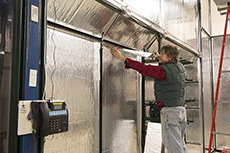Insulation installation at test beam facility
 |
Todd Nebel helps install insulation panels at MT6.2 at Fermilab's Test Beam Facility. Photo: Reidar Hahn
|
The largest enclosure of the Fermilab Test Beam Facility, called MT6.2, is getting a shiny, new look. What used to be a generic plastic- and cement-walled room now resembles something out of a science fiction film.
Six thousand square feet of aluminum-coated insulation will soon adorn the walls and ceiling in MT6.2. The insulation will help to maintain the room's temperature at 70 degrees Fahrenheit or less, which will be important when users take beam next year.
Many users bring equipment that works best at 70 degrees or less, such as sensitive detectors called silicon photo multipliers, said JJ Schmidt, who was responsible for determining the best type of insulation to use. Although the room has an air conditioning unit, its high ceilings and uninsulated walls did little to keep the heat out on a hot day.
"During the summer, the temperature would get to 85 degrees or higher, even with the air conditioning running," he said. "Users would try to cool their equipment with foil blankets, fans and portable A/C units."
In addition to providing a more convenient working atmosphere for users, the new insulation is also expected to reduce energy costs. On average, it costs several thousand dollars per year to run the air conditioning unit in MT6.2. Schmidt and his colleagues hope to reduce costs by about a third once the insulation installation is complete.
"Reducing energy costs is a nice bonus we're getting out of this project," said PPD mechanical operations specialist Todd Nebel, who is working on installing the insulation, along with Jerry Taccki and Gordon Gillespie. They hope to finish by the end of the year.
—Jessica Orwig
|